![[Flag of Colombia]](../images/c/co.gif) (2:3)
(2:3)  image by Željko Heimer, 20 May 2001
image by Željko Heimer, 20 May 2001
Last modified: 2024-03-02 by rob raeside
Keywords: education |
Links: FOTW homepage |
search |
disclaimer and copyright |
write us |
mirrors
![[Flag of Colombia]](../images/c/co.gif) (2:3)
(2:3)  image by Željko Heimer, 20 May 2001
image by Željko Heimer, 20 May 2001
See also:
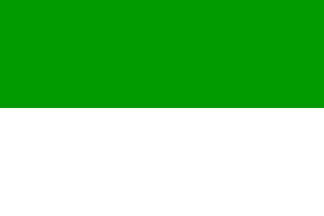 image by Ivan Sache, 11 Nov 2010
image by Ivan Sache, 11 Nov 2010
Colegio Santa Ana, located in Fontibón (Bogotá Capital District), was founded
in 1948 by Ligia Mendoza de Méndez.
The flag of Colegio Santa Ana, as shown graphically on the institute's website,
is horizontally divided green-white. Green means hope, vision of triumph and
continuity in duty. White represents ethical and moral honesty.
Source: school website
Ivan Sache, 11 Nov 2010
 image by Ivan Sache, 15 November 2010
image by Ivan Sache, 15 November 2010
Colegio Santa Ana de Flores is located in Simacota, Department of Santander.
The flag of Colegio Santa Ana de Flores, as shown graphically on the institute's
blog, is divided white-green by the ascending diagonal. White represents peace
and tranquility. Green represents the natural resources and hope in a better
future.
Source: this website
Ivan Sache, 15 Nov 2010
 image by Ivan Sache, 1 Jan 2021
image by Ivan Sache, 1 Jan 2021
Gimnasio Integral Santa Ana (GINSA) is located in Envigado (Antioquia).
The flag of GINSA is horizontally divided blue-pink, modeled on the
student's uniforms.
Blue symbolizes water as source of life, success,
tranquility and peace.
Pink symbolizes self-control, obedience and commitment
to service.
GINSA website
Ivan Sache, 1 Jan 2021
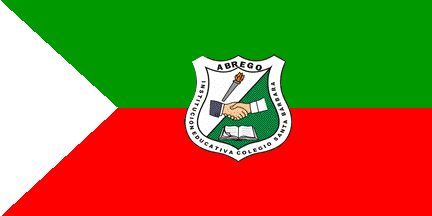 image by Ivan Sache, 14 Dec 2014
image by Ivan Sache, 14 Dec 2014
Institución Educativa Colegio Santa Barbara is located in Ábrego (Norte del
Santander Department).
The symbols of the institute were designed in 1979 under the guidance of Dubis
Isabel Ditta Altamar.
The flag is horizontally divided green-red with a white triangle placed along
the hoist. Green is a symbol of the exuberant and fertile natural environment of
the beautiful valley, and also a symbol of aspiration to a better future. Red is
a symbol of a brave nation, such as the Heborucos who once inhabited the
region. White is a symbol of peace aspired to by a village culturally marred by
violence.
The emblem is made of a Swiss-shaped shield divided white-green along the
ascending diagonal. The upper quarter is white, as a symbol of peace, charged
with a flaming torch representing sporting spirit. The lower quarter is emerald
green, representing aspiration to educate leaders for Ábrego, charged with an
open book inscribed with the institute's motto, "CIENCIA Y VIRTUD" (Science and
Virtue).
In the middle is a handshake, made of the adult hand of a teacher and of the
juvenile hand of a student, conveying a feeling of friendship and mutual aid.
Source::
http://www.colsaba.edu.co/index.php?option=com_content&view=article&id=72&Itemid=129
- Institute's website
Photos:
http://www.colsaba.edu.co/index.php?view=image&format=raw&type=orig&id=902&option=com_joomgallery&Itemid=123
http://www.colsaba.edu.co/index.php?view=image&format=raw&type=orig&id=1049&option=com_joomgallery&Itemid=123
Ivan Sache, 14 Dec 2014
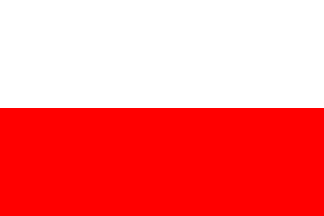 image by Ivan Sache, 18 July 2014
image by Ivan Sache, 18 July 2014
Colegio Santa Bertilla Boscardín was established in Medellín (Antioquia
Department) by the Congregation of the Teachers of Saint Dorothy, Daughters of
the Sacred Heart. The congregation was founded in 1836 in Italy by Giovanni
Antonio Farina (1803-1888; to be canonized on 23 November 2014 by Pope Francis;
Bishop of Trevise [1850] and of Vicenza [1860]) "to educate girls from poor
families" and recognized on 1 March 1839 by Pope Gregory XVI; in South America,
it has branches in Brazil, Colombia and Ecuador. The institute is named for St.
Maria Bertilla Boscardin (1888-1922; canonized on 11 May 1961 by Pope John
XXIII), who took the coat in Farina's congregation on 15 October 1905, as Sister
Maria Bertilla, and worked at the children's service of the Trevise hospital
from 1907 until her death.
The flag of the institute is horizontally
divided white-lilac pink. White is a symbol of candor and innocence of children.
Lilac pink is a symbol of the greatness and dignity of teenagers. Lilac forms a
balance between red and blue, symbolizing struggle and truce, acts and thoughts,
work and rest, scream and silence, study and recreation, emotionalism and
discernment, respectively. Lilac is also a symbol of nobleness and delicacy.
Source: institute website
Ivan Sache, 18 July 2014
 image by Ivan Sache, 14 Nov 2010
image by Ivan Sache, 14 Nov 2010
Colegio Santa Catalina de Siena, located in Maicao (Department of La
Guajira), is the main seat of Institución Educativa No. 3.
The flag of Colegio Santa Catalina de Siena, also used (by default) by
Institución Educativa No. 3, is shown on the institute's website as horizontally
divided white-red. White symbolizes peace and purity. Red symbolizes love. Peace
and love are presented as the two words that fostered St. Catherine of Siena's
life.
Source: school website
Ivan Sache, 14 November 2010
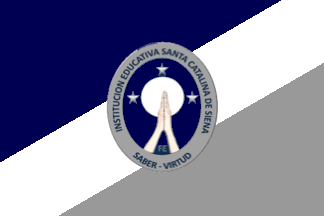 image by Ivan Sache, 3 January 2021
image by Ivan Sache, 3 January 2021
Institución Educativa Santa Catalina de Siena was established in 1993 in
Medellín in the premises of Colegio Santa María del Rosario, to be incorporated
on 2007 to INEM José Félix de Restrepo. The school was made autonomous by
Resolution No. 10,030 issued on 11 October 2013, under the erroneous name of IE
Santa Catalina de Sena, subsequently corrected.
The flag of IE Santa
Catalina de Siena is diagonally divided dark blue-white-gray from the lower
hoist to the upper fly, superimposed with the school's emblem.
Dark blue
denotes tranquility, authority, confidence and loyalty. This is the main color
transmitting power and the only one associated with stability and deepness. It
also represents knowledge, intelligence, faith and truth. Dark blue represents
knowledge, integrity, seriousness and power.
White is associated with light,
kindness, innocence, purity and virginity. It is considered as the color of
perfection, meaning security, purity and limpidity.
Gray means stability and
inspires creativity, also symbolizing success. Gray is associated with
independence, autonomy and self-control, since it is a color isolated from
external influence.
The emblem is oval, symbolizing a source of life. It
contains a border with the name of the institution. In the center are featured
hand in a praying, reflecting and contemplating attitude. The disc represents
the world, with three stars representative of the institutional values: Faith,
Knowledge and Virtue.
school website
Manual de Conviviencia
Ivan Sache, 3 January 2021
Obverse
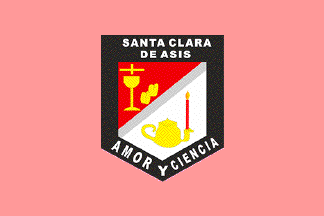 image by Ivan Sache, 30 June 2014
image by Ivan Sache, 30 June 2014
Reverse:
 image by Ivan Sache, 30 June 2014
image by Ivan Sache, 30 June 2014
Colegio Santa Clara de Asis was established on 22 January 1942 in Pasto
(Nariño Department) by Sisters Meinrada Wolf, Teolina Villegas, Ana Margarita
Osorio, Rosa Margarita Mantilla and Victoria Luisa Marín. The five nuns belong
to the congregation of the Franciscan Sisters of Mary Immaculate, founded in
March 1893 in Túquerres by Mother Caridad Bader.
The institute is named for St. Clare of Assisi (1194-1253; canonized on 26
September 1255 by Pope Alexander IV), one of the first followers of St. Francis
of Assisi (1181/2-1226; canonized on 16 July 1228 by Pope Gregory IX) and the
founder of the Order of St. Clare (Clarisses).
The flag of the institute is, on the obverse, pink with the institute's emblem
in the middle, and, on the reverse, green. Pink is a symbol of the joy of the
youth. Green is a symbol of search and aspiration to a promising future.
The emblem of the institute, adopted in 1971, was designed by Sister Damascena
Brunner. The shield is of modern Gothic shape, different from the ancient
Gothic shape by the point at the shield's bottom. The shield is divided by a
gray bend sinister, representing the girdle of St. Francis of Assisi. The dexter
field is red, a symbol of charity, love, force and blood, charged with a
chalice, a symbol of love, and with a bread and a cross, symbols of unity. The
sinister field is argent, a symbol of chastity, humility and limpidity, charged
with a lamp, a symbol of science. All the charges are yellow, except the candle
set in the lamp, which is red. The shield has a black bordure inscribed with
"SANTA CLARA DE ASIS" (top) and "AMOR Y CIENCIA" (Love and Science,
bottom) in white letters.
Source::
school webpage
Ivan Sache, 30 June 2014
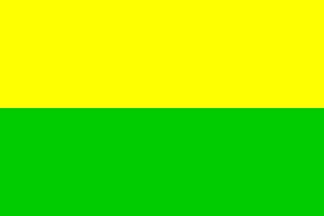 image by Ivan Sache, 03 July 2011
image by Ivan Sache, 03 July 2011
"Escuela Normal Superior Santa Clara" is located in Almaguer (Cauca Department). The flag of the institute, as shown on the institute's blog (photo), is horizontally divided yellow-green.
Source: scholl blog
Ivan Sache, 03 July 2011
 image by Ivan Sache, 05 Sep 2017
image by Ivan Sache, 05 Sep 2017
Liceo Moderno Santa Emilia was established in borough Santa Matilde, Puente
Aranda (Bogotá) by Elvia Rosa Palencia de Parra, as Jardín Infantil Preescolar
del Sur, registered on 17 March 1975 by Resolution No. 13. The institute was
renamed Liceo y Preescolar del Sur on 6 November 1985 by Resolution No. 6,489.
The flag of Liceo Moderno Santa Emilia is horizontally divided white-blue.
Source::
institute website
Ivan Sache, 05 Sepr 2017
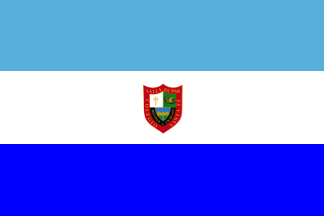 image by Ivan Sache, 13 May 2021
image by Ivan Sache, 13 May 2021
The present-day's flag of the school is horizontally divided light blue-white-dark blue. Light blue represents wisdom, faith and firm belief in God's love for human life. White represents the school's wise and transparent process. Dark blue represents truth, responsibility and loyalty to the principles and values of a community dedicated to the education of leaders able to build a pacific and powerful society to cope with global change.
https://www.facebook.com/colsafeoficial
Facebook account
displays as "Master flag" the tricolour, but only with
coat of arms
The coat of arms represent the philosophical, religious,
social and pedagogic cement of educative excellence. For Christians, the
prominent rector is God. Study and science are symbolized by a book and a quill.
The mountains and the river recall goals and honest in all acts. We shall
interact in the Global Village with "Kindness and Work" (the school's motto).
https://colsafe.edu.co/nuestro-simbolos/
Ivan Sache, 13 May 2021
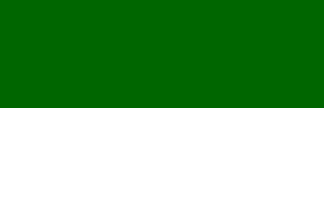 image by Ivan Sache, 4 Feb 2009
image by Ivan Sache, 4 Feb 2009
"Colegio Santa Fe" was founded in 1953 at Valledupar, Department of Cesar.
The flag of the institute, according to a photo and the
description available on the obsolete institute website, was horizontally divided green-white. Green symbolizes hope while white symbolizes transparency.
Ivan Sache, 4 Feb 2009
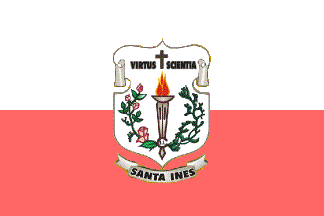 image by Ivan Sache, 09 Dec 2013
image by Ivan Sache, 09 Dec 2013
Colegio Santa Inés is a Franciscan educational institute based in Manizales.
The flag of Colegio Santa Inés is horizontally divided white-pink with the
institute's emblem in the middle. White and pink symbolize purity and youth,
respectively.
The emblem of Colegio Santa Inés features the Latin motto "VIRTUS
SCIENTIA" (Virtue and Science) and the flaming torch of science,
surrounded by spiny roses and thorns. The roses represent juvenile beauty; the
spines recall that beauty should be protected from those who threaten it or
attempt to rob its perfume.
The thorns recall that Jesus Christ designed our way on thorns.
Source: scholl's symbols page
Ivan Sache, 09 Decr 2013
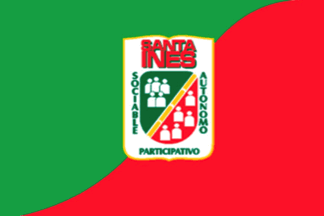 image by Ivan Sache, 30 July 2018
image by Ivan Sache, 30 July 2018
Colegio Santa Inés Campestre was established in 1963 in Palmira (Valle
department) by the Palmira-born teacher Nory Velasco de López. She was
succeeded in 1990 by her daughter, the lawyer María Dieny López de Campo.
School website
The flag of Colegio Santa Inés Campestre is divided green-red by a S-shaped
diagonal. The school's emblem is placed in the center. Green is a symbol of
aspiration (dreams and aims). Red is a symbol of firmness (compromise, love,
autonomy and leadership).
The upper quarter of the emblem represents
socialization, highlighted by the educational community working together to
achieve aims in the different processes of development. The lower quarter
represents autonomy, highlighted by individuals each having their proper and
particular identity. The quarters are connected by a dividing line representing
the gear that synthesizes individual and collective work as parts of integral
education.
school website
Ivan Sache, 30 July 2018
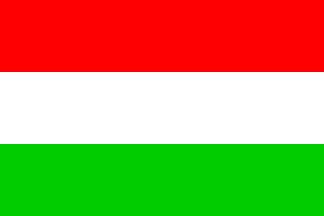 image by Ivan Sache, 07 July 2011
image by Ivan Sache, 07 July 2011
"Colegio Santa Isabel de Hungría", located in the Villabel borough,
Floridablanca (Santander Department), originates in the "Fundación Centro
Parroquial Villabel", founded on 28 February 1980 in the Santa Isabel de Hungría
(St. Elisabeth of Hungary) parish. On 25 November 1988, a secondary seat of "Gimnasio
José Alexandro Perralta", located in the Girón borough, was inaugurated in
Villabel. The institute took its current name on 25 October 1991.
The flag of the institute is described on the institute's website as "made of
three colors: red, white and green, in three horizontal stripes, strictly
identical to the stripes of the Republic of Hungary. The three colors mean:
strength, sacrifice, purity and hope."
Source:
http://www.colsih.edu.co/
Ivan Sache, 07 July 2011
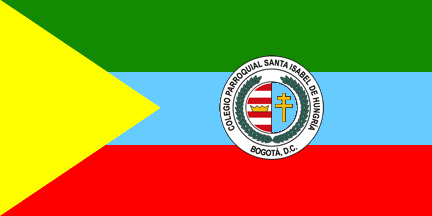 image by Ivan Sache, 10 Jan 2021
image by Ivan Sache, 10 Jan 2021
Colegio Parroquial Santa Isabel de Hungría was established in Muzú - Ospina
Pérez (Bogotá) in 1959 by Father Manuel Estévez Bretón.
The flag of the school is in proportions 1:2, composed of three horizontal stripes of the same
width, green, celestial blue, and red and a yellow equilateral triangle placed
along the hoist.
Yellow represents the Church in all its spiritual
colors: hope (green), faith (celestial blue) and red (love).
school website
The flag is charged with the school's emblem in the center.
Video
https://www.youtube.com/watch?v=EuAm_SDY0po
On the emblem, the
central disc symbolizes God's perfection and presence. It is modeled on the
lesser arms of Hungary. Dexter, the four fesses gules and three fesses argent
together symbolize the seven gifts of the Holy Spirit [wisdom, understanding,
counsel, fortitude, knowledge, piety, and awe (fear) of the Lord] and the
sacramentality of the Church. The crown or represents the school's patron saint,
St. Elizabeth of Hungary. Dexter, celestial blue is a manifestation of infinity
and symbolizes knowledge, friendship, loyalty, serenity, tranquility, eternal
truth and immortality. The double cross, offered by Pope Silvester II to King
St. Stephen I of Hungary in year 1000, represents the Roman Catholic Church.
The branches of green laurel were used in ancient Greece and Rome as awards for
poets, athletes and soldiers. Green is a symbol of life and intellectual
fecundity.
school website
Ivan Sache, 4 Aug 2018 / 10 Jan 2021
 image by Ivan Sache, 9 June 2001
image by Ivan Sache, 9 June 2001
Colegio de Santa Librada - 1:2 (apparently), quarterly divided
green-white-white-green The flag is shown on <
www.santalibrada.edu.co>,
located by Dov Gutterman.
Ivan Sache, 9 June 2001
"Colegio Distrital Santa Librada" is located at
Bogotá. The college is named after St. Librada (Liberata,
Livrade...), aka St. Wilgefortis, aka St. Uncomber, the patron
saint of women wishing to be "disencumbered" from
abusive husbands. Known as "the bearded virgin" but
without any historic background, the poor saint was removed from
the list of commemorated saints by the Roman Catholic Church in
1969.
The flag of the
institute, as shown graphically and described on the website
of the institute, is slightly higher than wide, white with an
aquamarine triangle pointing downwards charged with a white
rising sun. An alternative interpretation of the drawing is a
triangular light aquamarine flag with a white rising sun.
The sun represents light, energy, joy, commitment and solidarity
of all the members of the institute. White represents peace,
unity and the interest of the institute. Aquamarine
represents tranquility, future, strength and commitment to study
of the students.
Ivan Sache, 18 Jan 2009
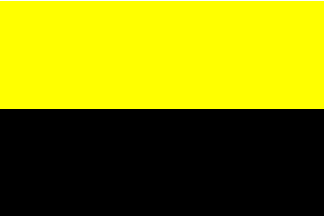 image by Ivan Sache, 24 July 2014
image by Ivan Sache, 24 July 2014
Colegio Provincial de Neiva (Santander Department) was established by
Provincial Ordinance on 26 September 1845. Classes in Spanish Grammar and Latin
started on 1 January 1849. The institute was subsequently renamed Colegio
Democrático (Ordinance No. 26 of 9 October 1850), Colegio de Santa Librada (Law
of 27 October 1870), and, eventually Colegio Nacional Santa Librada (Law No. 92
of 1937). The most famous student of the institute, mentioned in the institute's
anthem, is the writer José Eustasio Rivera (1888-1928), author of the naturalist
novel "La vorágine" (The Vortex, 1924), considered as the Colombian national
epic and as a milestone in the South American literature.
The institute
is named after St. Librada (Liberata, Livrade...), aka St. Wilgefortis, aka St.
Uncomber, the patron saint of women wishing to be "disencumbered" from abusive
husbands. Known as "the bearded virgin" but without any historical background,
the poor saint was removed from the list of commemorated saints by the Roman
Catholic Church in 1969.
The flag of the institute is horizontally
divided yellow-black.
Source: Luz Sary Herrera Cano's blog
Ivan Sache, 24 July 2014
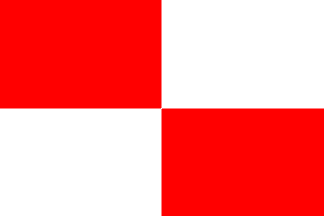 image by Ivan Sache, 13 May 2021
image by Ivan Sache, 13 May 2021
Liceo de Santa Librada originates in the Provincial College established
in Neiva (Huila Department) by a Decree issued on 26 September 1845.
Originally established for boys only, the school was appended a girl's
section by an Ordinance issued on 2 October 1848. The school was renamed
to Santa Librada on 20 July 1850, St. Librada's Day. The Neiva
Provincial Chamber issued on 9 October 1850 an Ordinance renaming the
boy's school to Democrático and the girl's school to Santa Librada; the
next year, the girl's school was suppressed because funds lacked and the
boy's school was renamed to Santa Librada. The girl's section was
re-established in 1880.
In 1939, the boy's school was nationalized and renamed to Nacional Santa
Librada, to be administrated by the Huila Department. The girl's section
was renamed to Liceo Feminino de Santa Librada.
Institución Educativa Liceo de Santa Librada was eventually organized by
Ordinance No. 20 issued in 13 June 1946 by the Assembly of the Huila
Department; administration of the school was transferred on 1 January
2003 to the municipality of Neiva, as prescribed by Law No. 715 "On the
Decentralization of Educational Service" promulgated in 2001. The
institute is composed of two seats, Liceo de Santa Librada and El Triángulo.
The flag of Liceo de Santa Librada is prescribed by Resolution No. 34
issued on 11 November 1992.
"The flag is of rectangular shape, divided in four equal parts, in turn
red and white, forming four central angles whose corners are equidistant
and concentric" (in a simpler way, quartered red and white).
White is a symbol of peace, abnegation, purity and sincerity.
Red is a symbol of strong-mindedness, force, love and glee.
Sources: school website and school symbols webpage
Ivan Sache, 13 May 2021
 image by Ivan Sache, 5 Jan 2009
image by Ivan Sache, 5 Jan 2009
"Colegio Parroquial Santa Lucía" was
founded in 1987 in Floridablanca by Father Silvano Poletto,
parish priest of Santa Lucía and legal representative in
Colombia of the religious community of the "Siervos de la
Caridad" (Servants of Charity), a community founded by the
Italian priest Luis Guanella (1842-1915, blessed in 1964).
The flag of the institute, as shown graphically and described on
the
website
of the institute, is vertically divided blue-white-yellow.
Blue represents the natural environment, empathy and respect of
the students for their surroundings, including humans and the
ecological environment.
White represents the light protecting the college and
enlightening our lives, as well as truth and transparency to be
attained by the students.
Yellow represents the Catholic faith and religious education.
The flag can be seen on a
photo,
as presented by the band of the institute.
Ivan Sache, 5 Jan 2009